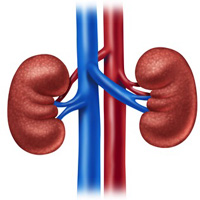Time dependant functional and morphological recovery of the kidney after relief of obstruction in patients with impacted ureteral stones

Accepted: May 2, 2021
All claims expressed in this article are solely those of the authors and do not necessarily represent those of their affiliated organizations, or those of the publisher, the editors and the reviewers. Any product that may be evaluated in this article or claim that may be made by its manufacturer is not guaranteed or endorsed by the publisher.
Authors
Objectives: To assess the course of functional and morphological recovery of the kidney following the relief of obstruction with ureteral JJ stent in cases with unilateral impacted stones.
Materials and methods: A total of 42 adult patients who were admitted to our clinic with unilateral obstructing impacted ureteral stones requiring JJ stent placement were included in the study. The course of functional recovery was assessed by evaluating the serum creatinine levels, renal resistive index (RRI) values and urinary levels of kidney injury molecule-1, neutrophil gelatinaseassociated lipocalin as well as microalbumin before at 1 day, 1 week and 4 weeks after JJ stent placement. Course of morphologic recovery was evaluated by evaluating the degree of hydronephrosis, kidney size, perirenal straining and ureteral diameter.
Results: Our results showed that all relevant parameters began to decrease after 24 hours and continue to normalize during 1 week evaluation; majority of these variables indicating the functional and morphological recovery were in normal range after 4 weeks. Decompression of the obstructed kidneys with JJ stent placement in patients with impacted ureteral stones was found to be effective enough with recovery of normal renal functional and morphological status after a minimum time period of 4 weeks. Morphological recovery of affected kidneys following JJ stenting was obtained with a significant difference between baseline and 1-month evaluation findings (p = 0.001, p < 001, p < 001, respectively). KIM-1 excretion began to decline to normal levels after 4 weeks (3.52 ± 0.99 ng/ml versus 2.84 ± 0.66 ng/ml, p < 0.001). The same findings were observed for the urinary excretion levels of NGAL, which normalized at the 1-month evaluation (604.55 ± 140.28 ng/ml versus 596.87 ± 80.17 ng/ml p = 0.895). Urinary microalbumin excretion levels however remained high even until 1-month follow-up with a statistically significant difference when compared with the normal excretion values (p < 0.001). There was a statistically significant difference in RRI values between baseline and 1-month follow-up findings in obstructed kidney (p < 0.001).
Conclusions: Elective management of the obstructing impacted ureteral stone(s) will be safer with limited risk of infective complications after functional and morphological normalization in such kidneys following 4 weeks of JJ stent placement.
How to Cite
PAGEPress has chosen to apply the Creative Commons Attribution NonCommercial 4.0 International License (CC BY-NC 4.0) to all manuscripts to be published.

 https://doi.org/10.4081/aiua.2021.2.178
https://doi.org/10.4081/aiua.2021.2.178



